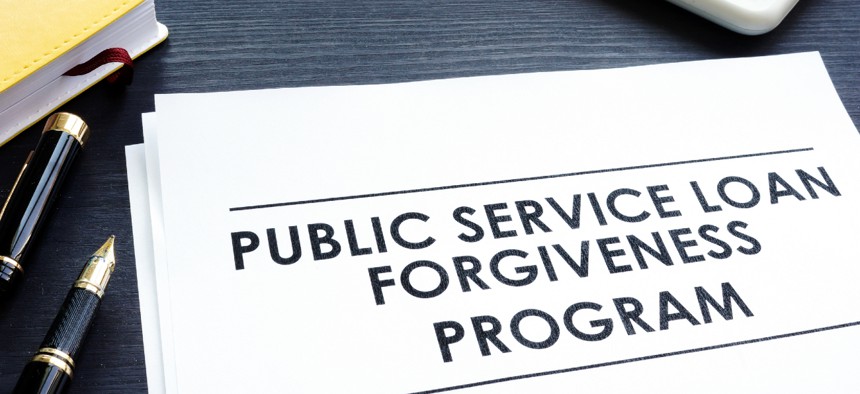
The program offers student debt forgiveness to college graduates who agree to work in government or a qualifying nonprofit organization. designer491/Getty Images
House Lawmakers Have Proposed Restructuring Public Service Loan Forgiveness
A new bill would provide partial forgiveness for every year’s worth of loan repayments and expands what loans and repayment plans would qualify for the program.
A pair of House Democrats on Wednesday announced new legislation aimed at making it easier for federal employees and other public servants to access the Public Service Loan Forgiveness Program by restructuring how it pays out forgiveness and expanding what loans qualify for the program.
Introduced in September but not publicized until this week, the Public Service Reward Act (H.R. 9097), sponsored by Reps. Jim Clyburn, D-S.C., and Brendan Boyle, D-Pa., builds upon a number of recent actions by the Biden administration to make the program, which offers student debt forgiveness to college graduates who agree to work in government or a qualifying nonprofit organization, less of a headache to navigate.
According to data from the Education Department, the program has thus far forgiven $13.4 billion in student loan debt as of Aug. 31, of which $11.9 billion was forgiven due to a year-long temporary waiver that expired Monday. The administration has published a series of proposed regulations to make many of the reforms from that temporary waiver permanent, although those rules won’t be implemented until next July.
Clyburn and Boyle’s bill would fundamentally change how the program forgives debt. Instead of applicants having to spend 10 years making monthly payments on their loans in order to be considered for forgiveness, the Education Department would spread out that forgiveness over the course of a decade, making applicants eligible to have a portion of their loans forgiven each time they have made 12 qualifying loan payments. That change would apply retroactively to applicants who have already made at least a year’s worth of payments under the current system.
For the first five years’ worth of payments, the Education Department would forgive all interest accrued. For years six through nine, their interest again would be forgiven, as well as 5% of an applicant’s total outstanding loan balance. And after the final year, the remaining balance would be forgiven.
Additionally, the bill would expand what loans are eligible for the program. Only Direct Loans are currently eligible to be forgiven through Public Service Loan Forgiveness, although the temporary waiver gave applicants an opportunity to consolidate non-qualifying loans into Direct Loans. Under the bill, Direct Loans, Federal Family Education Loans, Perkins Loans, direct consolidation loans and Parent Plus Loans all would be eligible for forgiveness, and debt consolidations would no longer reset borrowers’ repayment clocks for the purpose of pursuing forgiveness.
And it would expand what repayment plans are eligible for the program, to include income-based repayment plans, income-contingent repayment plans, pay as you earn and revised pay as you earn plans, as well as standard plans.
“Student loan borrowers entering public service after obtaining their degrees provide great value to our communities and country,” Clyburn said in a statement. “This bill incentivizes more Americans to seek careers in public service and restores the promise of the PSLF program to millions of working people. I remain committed to providing borrowers who make significant sacrifices to provide public services with relief from the crushing debt associated with higher education and giving the next generation the opportunity to pursue the American dream.”
NEXT STORY: The Benefits of Working After Retirement







